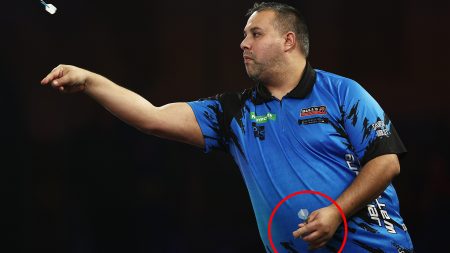The highly anticipated Premier League clash between Liverpool and Leicester City at Anfield was marred by a thick blanket of fog that descended upon Merseyside, significantly impacting visibility and sparking widespread frustration among fans watching the game. The heavy fog created an almost surreal atmosphere, obscuring the players and making it challenging to follow the action on television screens. This led to a barrage of complaints from viewers who expressed their displeasure at the poor viewing experience. Many took to social media to vent their frustrations, describing the game as “unwatchable” and lamenting the wasted time spent staring at a fog-filled screen.
The fog was so dense that it prompted concerns about the game’s feasibility. Comparisons were drawn to a nearby match between Tranmere Rovers and Accrington Stanley, which had been abandoned due to similarly adverse weather conditions. Despite the prevailing fog, Liverpool had issued a pre-match statement advising fans attending the game to allow extra travel time due to the poor visibility. However, the extent of the fog’s impact on the viewing experience seemingly caught many off guard, leading to widespread disappointment and anger among those watching from home.
Social media platforms were inundated with complaints from viewers struggling to discern the action on the pitch. The prevailing sentiment was one of frustration, with many feeling cheated out of the opportunity to watch a top-flight football match. Some commentators resorted to humor, comparing the experience to watching a blank screen or suggesting the broadcast cameras were positioned behind clouds. Even Specsavers, the well-known opticians, joined the online conversation, highlighting the poor visibility with a tongue-in-cheek remark directed at the broadcasting platform.
The on-field action, despite the challenging conditions, provided some excitement. Leicester City, defying pre-match expectations, took a surprise early lead through a goal by Jordan Ayew. This unexpected turn of events momentarily shifted the focus away from the fog, injecting some much-needed drama into the contest. Liverpool, however, quickly responded with an equalizer from Cody Gakpo, restoring parity and setting the stage for a potentially thrilling encounter. The fog, however, continued to be a major talking point throughout the match, overshadowing the on-field proceedings.
Beyond the immediate frustrations surrounding visibility, the fog also raised questions about the decision to proceed with the game. With the Tranmere Rovers match having been abandoned due to similar conditions, some questioned whether the Liverpool-Leicester game should have also been postponed. The debate highlighted the difficult balance between prioritizing player safety and spectator experience against the logistical challenges of rescheduling matches. The incident underscored the impact of unforeseen weather events on the smooth running of sporting events and the need for robust contingency plans.
The foggy encounter between Liverpool and Leicester City served as a stark reminder of the influence of weather on the enjoyment and accessibility of sporting events. While the fog undoubtedly added an unusual dimension to the match, it ultimately detracted from the viewing experience for a significant number of fans. The incident sparked a wider conversation about the decision-making process surrounding playing conditions and the importance of prioritizing both player safety and the interests of spectators, whether present at the stadium or watching remotely. The widespread complaints on social media highlighted the expectation of a clear and unobstructed view, particularly in the age of high-definition broadcasting and paid subscriptions for sports content.











